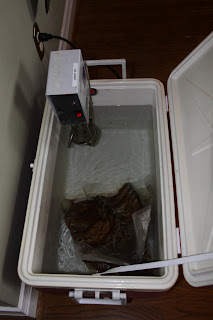When I was in culinary school we did discuss sous vide cooking, for about 10 minutes. The equipment to do it properly is expensive and the school wasn't willing to make the investment. The closest thing we did was poaching salmon in 120-130 degree olive oil. Lately I've become more interested in trying this technique so I started looking for the equipment.
The basic equipment for cooking sous vide includes a vacuum sealer
The box arrived on a day I had taken off work, so I was able to play around with it immediately. When I set it up in a pot of water and turned it on, it was VERY loud. It was also causing the GFCI in the kitchen to flip off. After disassembling the unit and giving it a thorough cleaning the noise problem was solved, but it still has an issue with GFCI. No problem, as long as it isn't plugged in to a kitchen or bathroom outlet everything works fine! The next day I started my first vacation in over a year, but since I was going to visit family I just brought along my new toy so I could continue to play. I found an old 48 quart Igloo cooler in my parents basement that served well as the water bath.
My first foray in to sous vide was pork back ribs. I made a rub using whatever appropriate spices I could find, applied it to the ribs and sealed them up in vacuum bags. The ribs were placed in a 150 degree water bath and allowed to stay there for about 14 hours before being removed and placed in the refrigerator to cool. That was a nervous night, I had never run the circulator for so long and didn't know if it could take the abuse and the cooler I was using for the bath had a drain on the bottom that I was afraid would pop open due to the temperature and flood the room. I read somewhere that chilling the ribs in the pouches after cooking allows the meat to firm up, no idea if this step is actually needed or not. I had always been told that collagen breaks down to gelatin at a little below boiling temperature, but the huge amounts of gelatin present when the bags were opened the next day proved that is wrong. The ribs were dried off and heated up on a hot grill to produce a nice crust. The meat was still pinkish, which some members of the family didn't like, but it was extremely tender and moist.
The next thing I tried was filet mignon. They were seasoned with garlic salt and a product called Dale's Seasoning Sauce
When I returned home, the first thing was to get another cooler, preferrably one without a drain. I found another Igloo cooler for $20 that is a perfect fit for the circulator's mounting bracket. It is also 48 quart so there is enough room for just about anything I want to cook and has no drain at the bottom. More difficult to empty, but I'll be able to sleep better when it the circulator is running. My first dish cooked at home was sous vide salmon. First i put a tablespoon of olive oil in the bag and put it in the freezer until the oil had solidified. The salmon was seasoned simply with Lawry's Seasoned Pepper, lemon juice and fresh dill. The bath was set to 122 degrees and the cooking time was 40 minutes. The fish was removed from the bag and the skin side was seared briefly in olive oil to crisp it up a bit. The texture and flavor were amazing! I served it with some sauteed spinach for a very tasty and healthy meal. Next up? I'm thinking of cooking some potatoes sous vide for a Memorial Day potato salad.




That is so adorable!!! What a great idea!! Cooking Equipment
ReplyDelete